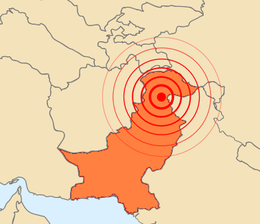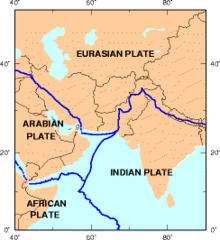2005 Kashmir earthquake: Difference between revisions
m Reverted edits by 70.127.77.70 (talk) to last version by Bento00 |
|||
| Line 75: | Line 75: | ||
===Information=== |
===Information=== |
||
* [http://thecurrentaffairs.com/ Pakistan News] |
|||
* [http://www.kirf.org Kashmir International Relief Fund] |
* [http://www.kirf.org Kashmir International Relief Fund] |
||
* [http://www.kct-uk.org Kashmir charitable trust UK] |
* [http://www.kct-uk.org Kashmir charitable trust UK] |
||
Revision as of 09:22, 19 April 2010
 | |
| UTC time | ?? |
|---|---|
| Magnitude | 7.6 Mw |
| Depth | 10 km |
| Epicenter | Muzaffarabad, AJK |
| Areas affected | |
| Casualties | 79,000 dead (18th deadliest earthquake of all time) 106,000+ injured |
The 2005 Kashmir Earthquake was a major earthquake centered in Pakistan-administered Kashmir known as Azad Kashmir, near the city of Muzaffarabad, affecting Gilgit-Baltistan and North-West Frontier Province (NWFP) regions of Pakistan. It occurred at 08:52:37 Pakistan Standard Time (08:57:32) UTC) on 8 October 2005. It registered a moment magnitude of 7.6 making it similar in size to the 1906 San Francisco earthquake, the 1935 Quetta earthquake, the 2001 Gujarat earthquake, and the 2009 Sumatra earthquakes. As of 8 November, the government of Pakistan's official death toll was 79,000. The earthquake also affected countries in the surrounding region where tremors were felt in Tajikistan, western China; while officials say nearly 1,400 people also died in Indian-administered Kashmir and four people in Afghanistan. The severity of the damage caused by the earthquake is attributed to severe upthrust, coupled with poor construction.
Well over US$ 5 billion (400 billion Pakistani rupees) [1] Aid arrived from all around the world with American US marine helicopters stationed in neighbooring Afghanistan quickly flew in aid to the devastated region. Five crossing points were opened on the Line of Control (LoC) between India and Pakistan to facilitate the flow of humanitarian and medical aid to the affected region, and international aid teams from around the world came to the region to assist in relief.[2] [3] [4]
The earthquake

Pakistan-administered Kashmir lies in the area of collision of the Eurasian and Indian tectonic plates.[5]. The geological activity born out of this collision, also responsible for the birth of the Himalayan mountain range, is the cause of unstable seismicity in the region. The Pakistan Meteorological Department estimated the 5.2 magnitude on the richter scale. The United States Geological Survey (USGS) measured its magnitude as a minimum of 7.6 on the moment magnitude scale, with its epicentre at 34°29′35″N 73°37′44″E / 34.49306°N 73.62889°E, about 19 km (11.8 miles) northeast of Muzaffarabad, Pakistani Kashmir, and 100 km (65 miles) north-northeast of the national capital Islamabad. The earthquake is classified as "major" by the USGS. The hypocenter was located at a depth of 26 km (16.2 miles) below the surface [6]. The Japan Meteorological Agency estimated its magnitude at a minimum of 4.6. By comparison, the 2004 Indian Ocean earthquake had a magnitude of 9.15. The earthquake caused widespread destruction in northern Pakistan, as well as damage in [Afghanistan and adjacent Kashmir currently under Indian occupation. The worst hit areas were Pakistani Kashmir, Pakistan's North-West Frontier Province (NWFP), western parts of Indian-administered Kashmir valley. It also affected some parts of the Pakistani province of Punjab, the capital city of Islamabad, and the city of Karachi experienced a minor aftershock of magnitude 4.6. There have been many secondary earthquakes in the region, mainly to the northwest of the original epicentre. A total of 147 [aftershocks were registered in the first day after the initial quake, of which one had a magnitude of 6.2 [6] Twenty-eight of these aftershocks occurred with magnitudes greater. On October 19, a series of strong aftershocks, one with a magnitude of 5.8,[6] occurred about 65 km (40.5 miles) north-northwest of Muzaffarabad.[7] As of 27 October 2005 [8] there have been more than 978 aftershocks with a magnitude of 4.0 and above that continue to occur daily. (See USGS for a list of recent aftershocks and effects.) Since then, measures from satellites have shown, that mountain parts directly above the epicenter have risen by a few meters, giving ample proof, that the rising of the Himalayas are still going on, and that this earthquake was a consequence of that.[9]
Casualties
| 2005 Kashmir earthquake casualties | |||
| Location | Dead | Injured | |
| NWFP, Pakistan Pakistani Kashmir | 73,338 | 100,000 | |
| Indian Administered Kashmir | 1,360 | 6,266 | |
| Afghanistan | 4 | 14 | |
| Total | 74,500+ | 106,000+ | |
Most of the casualties resulting from the earthquake were in Pakistan where the official confirmed death toll is 74,698, putting it higher than the massive scale of destruction of the 1935 Quetta earthquake.[10] International donors have estimated that about 86,000 died but this has not been confirmed or endorsed by Pakistani authorities.
As Saturday is a normal school day in the region, most students were at schools when the earthquake struck. Many were buried under collapsed school buildings. Many people were also trapped in their homes and, because it was the month of Ramadan, most people were taking a nap after their pre-dawn meal and did not have time to escape during the earthquake. Reports indicate that entire towns and villages were completely wiped out in Northern Pakistan with other surrounding areas also suffering severe damage.
- "...a second, massive wave of death will happen if we do not step up our efforts now", Kofi Annan said on 20 October with reference to the thousand remote villages in which people are in need of medical attention, food, clean water and shelter and the 120,000 survivors that have not yet been reached." [11]
According to Pakistan's Interior Minister Aftab Ahmad Sherpao, Prime Minister Shaukat Aziz
- "made the appeal to survivors" on 26 October to come down to valleys and cities for relief,[2] because bad weather, mountainous terrain, landslides and blocked roads are making it difficult for relief workers to reach each house and the winter snows are imminent."
In Islamabad, the Margala Towers, a apartment complex, collapsed and killed many of the residents.
Afghan territory
Four deaths were reported in Afghanistan, including a young girl who died in Jalalabad after a wall collapsed on her. The quake was felt in Kabul, but the effects were minimal.
See also
Notes
- ^ "The Illinois International Review - The Pakistan Earthquake of October 2006: A Reminder of Human-Science Interaction in Natural Disasters Risk Management". Archived from the original on 2009-05-16. Retrieved 2009-03-16.
{{cite web}}: Unknown parameter|deadurl=ignored (|url-status=suggested) (help) - ^ a b "Pakistan Asks Quake Survivors to Leave Mountains Before Winter" (Bloomberg), Bloomberg.com, 26 October 2005, retrieved 24 February 2006 Cite error: The named reference "bloomberg1" was defined multiple times with different content (see the help page).
- ^ "New figures put quake toll at more than 79,000" AP, ,,MSNBC.com, 19 October 2005, retrieved 23 February 2006
- ^ "South Asia Earthquake: Fact Sheet #25 (FY 2006)" Reliefweb.com, 17 November 2005, retrieved 23 February 2006
- ^ "A Biography of the Himalaya". Archived from the original on 2009-10-22.
{{cite web}}: Unknown parameter|deadurl=ignored (|url-status=suggested) (help) - ^ a b c USGS Earthquake Hazards Program
- ^ "Pak in panic as quake rocks Kashmir" Reuters, The Financial Express, 19 October 2005, retrieved 23 February 2006
- ^ "Pakistan: A summary report on Muzaffarabad earthquake" ReliefWeb, 7 November 2005, retrieved 23 February 2006
- ^ BBC series: Earth: The Power of the Planet, part 1. Volcano
- ^ BBC News – Earthquake toll leaps to 73,000
- ^ "Thousands at risk of starving in earthquake aid shortfall" The Times, 21 October 2005, retrieved 24 February 2006
References
- "A crisis of neglect". (6 November 2005). New Sunday Times, p. 18.
- "Pneumonia hits Pakistan quake zone". (8 November 2005). New Straits Times, p. 6.
- "Quake death toll now 87,350". (29 November 2005). New Straits Times, p. 6.
External links
Information
- Pakistan News
- Kashmir International Relief Fund
- Kashmir charitable trust UK
- Kashmir Relief & Development Foundation (KRDF)
- Summary report on Muzaffrabad Earthquake
- Special Event Page, Amateur Seismic Centre, India
- national volunteer movement
- Geological Survey of Pakistan
- WikiPakistan Earthquake – News and information on the earthquake related to India and Afghanistan.
- PakistanQuake.Com
- Oxfam America's South Asia Earthquake page
- MuzaffarabadOnline.Com
- Islamic Charity Ummah Welfare Trust Helps Those Affected
Multimedia
- Earthquake Picture Gallery
- Kashmir Earthquake Appeal (KRDF Videos)
- Severe Earthquake Jolts Pakistan GEO TV (Videos)
- Template:Google video
- Annotated google map of the earthquake area, with photos (Map)
- Why did the news interest fade so quickly on the 2005 Kashmir quake? - Produced by Yuli Yang (News Documentary)
- Life in Kashmir Half a Year after the Quake (Part I) - Produced by Yuli Yang (News Documentary)
- Life in Kashmir Half a Year after the Quake (Part II) - Produced by Yuli Yang (News Documentary)
- Journal of relief work in Pakistan (pictures, text, audio)
- Hope Floats - A series of documentaries Directed by Azfar Rizvi 2005
News articles
- "Photo journal: Earthquake in Uri Village". BBC News. October 10, 2005.
- "Quake prone constructions coming up". Kashmir Newz. October 7, 2006.
- "Photo journal: Return to Uri Village". BBC News. October 31, 2005.
- "Rich world 'failing' on quake aid". BBC News. October 26, 2005.
- "Quake 'is UN's worst nightmare'". BBC. October 20, 2005.
- "In Depth: South Asia Quake". BBC News. October 9, 2005.
- "Line of Control". D.C. Hammer. October 16, 2005.
- "Pakistani journalists send mission to assess damage to local media". IFEX. October 18, 2005.
- "A tale of two disasters -- and two responses". DelwareOnline. November 20, 2005.
- "Aftershock: Gideon Yago's Diary In Pakistan". MTV News. 2005.
Commentary
- One year on Kashmir Earthquake haunts survivors by Zafar Sharif
- Christian Science Monitor October 14, 2005
- "Getting Things Done". Slate (magazine). October 14, 2005.
- "Pakistan: Death and Distrust in Kashmir". Der Spiegel. October 17, 2005.
- "Quake highlights Kashmir dispute". BBC News. December 21, 2005.
- "Why did the news interest fade so quickly on the 2005 Kashmir quake?" – Produced by Yuli Yang / May 2006 (News Documentary)
- "Kashmir: politics of an Earthquake" by Jan McGirk October 19, 2005
General
- Conflict in Kashmir: Selected Internet Resources by the Library, University of California, Berkeley, USA; University of California at Berkeley Library Bibliographies and Web-Bibliographies list
